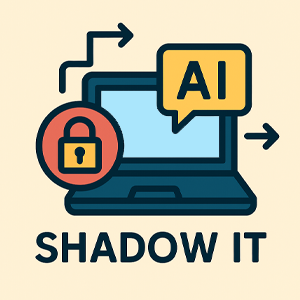 Remember the days when Shadow IT meant a rogue Dropbox account or an unsanctioned Slack workspace? Those were simpler times. In 2025, Shadow IT has evolved, and generative AI is its new accelerant.
Remember the days when Shadow IT meant a rogue Dropbox account or an unsanctioned Slack workspace? Those were simpler times. In 2025, Shadow IT has evolved, and generative AI is its new accelerant.
With tools like ChatGPT, Claude, Midjourney, and Perplexity becoming essential to productivity, employees aren’t waiting for IT approval. They’re signing up, integrating, and automating workflows independently. While this shows initiative, it also exposes businesses to new layers of risk, security blind spots, compliance violations, and uncontrolled data sharing.
The New Shape of Shadow IT: AI-First, Fast-Moving, and Hard to Detect
The democratization of AI means any employee with a credit card can start using powerful tools—often with little understanding of where the data goes or how secure the system really is.
Some common examples:
-
Marketing teams generating ad copy with ChatGPT or Jasper without vetting content for brand or legal risks
-
Designers using Midjourney to create graphics without confirming licensing rights or originality
-
Analysts feeding confidential data into Claude or Gemini Advanced to summarize financial models or customer feedback
-
Customer service reps using AI chatbots to speed up replies completely disconnected from IT or security oversight
These aren’t hypothetical. They’re happening in B2B organizations across industries right now.
Why It’s Tempting: The Upside of AI in the Wild
Let’s be honest, employees aren’t doing this to be sneaky. They’re doing it because it works.
-
Speed: AI slashes turnaround times on content, insights, and decisions
-
Autonomy: Teams can optimize workflows without waiting for formal IT deployments
-
Creativity: AI tools open new doors for ideation, design, and experimentation
-
Pressure to Perform: Deadlines and deliverables don’t wait for security audits
When your competitor’s marketing team is publishing 10x the content using AI, it’s hard to justify sticking to manual processes.
The Risks: What IT and Security Leaders Need to Know
But the convenience comes at a cost. GenAI-enabled Shadow IT creates a wide range of threats:
-
Data Exposure: Sensitive company, customer, or financial data may be sent to AI tools that store prompts, train on inputs, or lack proper encryption
-
Regulatory Violations: HIPAA, GDPR, and industry-specific rules can be breached without anyone realizing it
-
IP Leakage: Proprietary product plans or creative assets might be absorbed into public models
-
Lack of Accountability: Who owns the output? Who checked the accuracy? Shadow AI tools often produce content without review or version control
The biggest danger? You don’t know what you don’t know. And what’s invisible can’t be audited.
How to Respond: Enable Innovation Without Losing Control
The solution isn’t banning AI tools. It’s governing them. Here’s how leading IT teams are tackling this issue:
-
Create an AI Usage Policy
Define what tools are allowed, what data is off-limits, and what review processes must be followed. Make it clear and accessible. -
Build a Registry of Approved AI Tools
Evaluate and whitelist AI platforms based on security, compliance, and vendor transparency. Give teams safe, fast options so they don’t need to go rogue. -
Educate and Train Employees
Many users don’t realize the risks. Host quick sessions on data handling, prompt engineering best practices, and model limitations. -
Implement Visibility Tools
Use endpoint monitoring and cloud access security brokers (CASBs) to detect AI tool usage outside the approved list. -
Establish an AI Governance Task Force
Include stakeholders from IT, legal, HR, and business units. Make it a cross-functional initiative-not just a security lockdown.
Conclusion: Make Shadow AI Work with You, Not Against You
Generative AI isn’t going away. If anything, its adoption is accelerating and the line between “authorized tool” and “Shadow IT” is blurring. By creating smart policies, building trust, and offering secure AI options, you can foster innovation and protect your business.
The real threat isn’t AI. It’s the lack of oversight around how it’s being used.
